One of the most popular topics on the Frosty Garden blog is the subject of growing outdoor tomatoes in the far north.
We also grow a fair number of peppers outdoors in our cold climate, so it’s time for some of our top tips for growing peppers in a relatively cool climate!
We’ve found great success with growing outdoor peppers in the interior of Alaska. They often do better most years than our tomatoes. While we don’t have bushy six foot tall pepper plants, we always get a decent harvest of peppers.
Stick With Basic, Early Varieties
Unlike with tomatoes, there are very few varieties that have been bred for cold climate growing. With peppers, there are just some types that do better than others in cold climates.
In general, it’s a good idea to do a bit of research on the varieties you might want to grow. For best results, seek pepper varieties that reach maturity in the 50 to 75 day range.
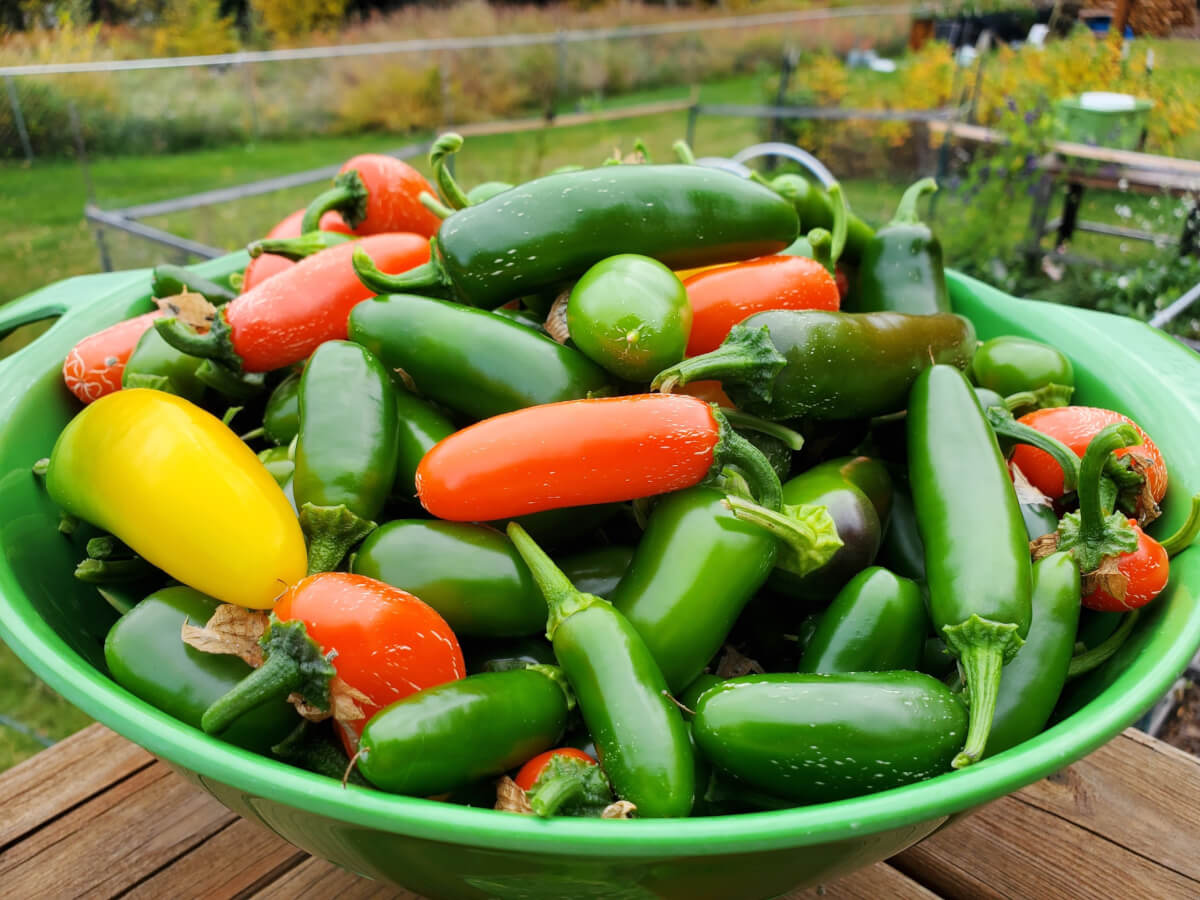
This is one of our harvests of jalapeno peppers. Jalapenos are great early producers, typically harvestable within 50-60 growing days.
With peppers, the estimated day to maturity is an edible, but green pepper. That green pepper may not be what you have in mind for a “ripe” pepper.
It can take days to weeks to months longer for a pepper to change colors (fully ripen), and it usually requires a good streak of warm weather for that to happen. This time is determined entirely by the type of pepper you are growing.
The problem with peppers grown at extreme northern latitudes is prime time ripening season is often hampered by relatively cool, rainy days. You don’t always get that good streak of warm weather!
For pure outdoor growing, our experience has shown that some of the most basic pepper varieties do the best here in Alaska. You’ll notice that most of them are considered “ripe” when they are still green. Examples of these include:
- Jalapeno (early varieties)
- Serrano
- Anaheim
- Poblano
- Cayenne
- Habanero (Early type only, 80 day)
- Banana wax peppers (hot & mild)
- Thai peppers
- Shishito (Padron is a genetic equivalent)
- Bulgarian carrot pepper (also known as Shipka)
- Lunchbox pepper
We’ve had great success with outdoor grown early varieties of jalapenos. These are usually our most prolific plants, sometimes providing a dozen or more peppers from each plant. These can even continue to put on peppers if you harvest them mid-summer.
With peppers that require some maturity to be right, it can often take some finessing to get them to full maturity. We will discuss some of the techniques we use further in this post. These techniques allow us to grow any kind of pepper to full maturity.
A greenhouse provides the northern gardener the an additional tool when it comes to growing peppers to full maturity. Even then, early peppers are still strongly desirable.
Growing some of the more obscure hot peppers in the subarctic is not exactly a straight forward, sure fire proposition.
Forget About Growing Bell Peppers
At least here in the subarctic, you most likely won’t be growing full size bell peppers very successfully outdoors. At lower latitudes, you can be more successful, but not in the extreme north.
We have tried several different varieties of bell peppers outdoors, even the most early varieties, and the poor yields just make them not worth growing.
Our experiments have largely been with the Ace hybrid and a few other medium sized, early maturing bell pepper varieties. Unfortunately, we’ve only been able to get 1-3 fruit that will grow to full maturity. More often than not, we only achieve partial maturity.
At that point, you’re probably paying $5+ per pepper and it’s only about two to three inches in diameter.
If you really, really want to try bell peppers, our best results have been with a variety called Staddon’s Select.

This was our bell pepper harvest from TWO plants, grown outdoors. Traditional bell peppers are low producers in the subarctic.
For us, these results are just too marginal for us to put significant resources into growing them.
If you are looking for a sweet pepper, we’d recommend trying some specific varieties that are known to produce prolifically and very early:
- Lunchbox peppers (55 day)
- Miniature yellow bell (55 day)
- Miniature red bell (55 day)
- Shishito (50 to 60 day)
Our advice is to experiment with any particularly small, sweet peppers with very early maturity. Typically you’re looking for maturity ranges in the 50-60 day range.
You might notice some of the varieties above have “bell” in the name, but all of these varieties are much smaller and resemble many hot pepper counterparts in shape and size.
If you have a greenhouse, you can produce the “mini bell” varieties with even better proficiency.
Also, a greenhouse does open options to experiment with more full-size bell peppers. In our opinion, though, production is still marginal with most common bell pepper types.
Get An Early Start On Your Peppers
In most northern climates, there is not enough growing season to get a pepper plant to full maturity, grown entirely outdoors.
If you want to raise your own peppers from seed in the north, you will need to start them indoors. You can also purchase pepper starts from a nursery.
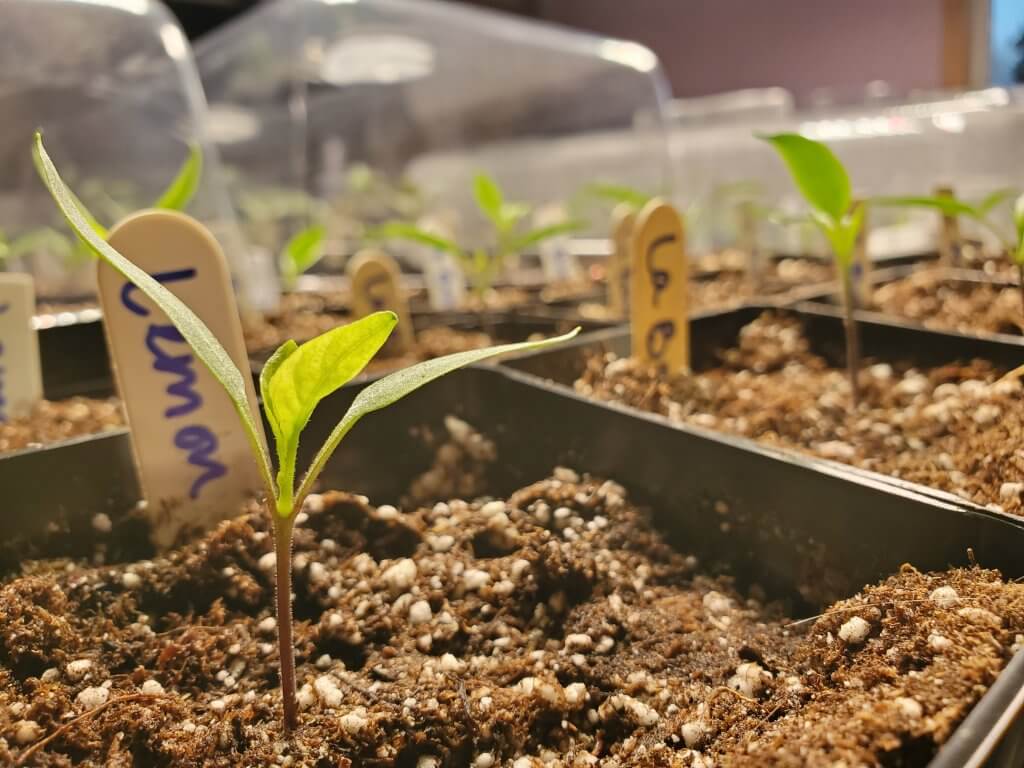
Most pepper growers will want to plant seeds 7-8 weeks before last frost. The earlier of those dates will ensure a larger transplant and better pepper production. Your pepper plants will also be larger, so make sure your indoor growing space can accommodate this.
If you have access to a temperature controlled greenhouse, or if your growing space can accommodate 8 to 12 inch plants, you can start your peppers 9-12 weeks before last frost. Starting peppers this early results in some large pepper starts, but they are often still a manageable size!
Peppers need relatively warm soil temperatures to germinate, typically around 70 degrees. If you are growing with ambient light near a window, or a place such as a garage, you may see troubles with germination.
You can use alternative germination techniques, such as germinating the seeds in a paper towel, to help get an initial seed to sprout. You can also use a gentle heat mat to increase the soil temperatures.
If you are buying pepper plants, look for fairly mature plants, typically around 12 to 18 inches tall. Don’t settle for a pepper plant that is smaller as it will still need to spend a lot of time growing to size and will produce less. In some cases, it should even have some early fruit on it.
You want the summer’s warmth to be spent on producing fruit, not getting the pepper plant to basic, fruiting maturity.
Remove Early Flowers From Your Plant
If you’re raising your own peppers, it’s important to understand the relationship between plant size and flowering.
When a pepper flowers, it shifts it’s focus into fruit production as opposed to general growth and size.
Should you want to achieve a physically larger pepper start, you can remove early flowers from the plant. This will cause the plant to continue its focus on getting larger.
As a general guideline, we try to remove flowers that appear up to about a week or two before we transplant to their final home.
There are some exceptions to this! For longer maturing peppers, like ghost, habanero and “most” particularly hot peppers, there is wisdom to leaving the early flowers on the plant to produce peppers. These varieties often need the entire summer season to fully mature!
Remember, this is a balance you’re trying to achieve. In cold climates, you need to allow the plant enough time to fruit and mature that fruit.
This can be especially beneficial when combining early seeding dates of peppers. Just make sure you have the room for it. Larger garden starts also usually require larger growing pots, too.
Transplant Peppers 1-2 Weeks After Last Frost
An unexpected late frost or cold snap can devastate a pepper plant. This is a very real risk in our northern cold climate.
Peppers are much more sensitive to cooler temperatures than tomatoes are.
Putting peppers outside when the temperatures are still in the 30’s to 40’s can seriously stunt their growth. This can negatively affect the pepper’s growth over its entire life.
We’ve found it a best practice to put peppers outside when the evening temperatures are virtually guaranteed to be over 50 degrees. We sometimes push high 40’s, but try to avoid it if possible.
How we assess this is by looking at the 10 day forecast, and expected low temperatures, around our last frost date. If we see anything dip into the 40’s, we don’t transplant outdoors!

This time frame can be anywhere from around last frost to about two weeks after last frost. In rare cases, we’ve even seen this push three to four weeks after our last frost.
This is one of the main reasons for one of our later recommendations, using larger transplant pots.
We have had some rare years where the early season just doesn’t warm up. Sometimes we just have to take our chances. If the weather pushes us beyond two weeks after last frost, we often take the risk and plant peppers while 40 degree temperatures are still common.
Also, you can certainly use the time around last frost for hardening off your peppers to both sunlight and our cooler northern temperatures. As the evening temperatures approach 50+ degrees, you can leave them outside if they’ve been sufficiently hardened off.
Keep bringing your pepper plants inside, pretty much any time temperatures are expected to get into the 40’s.
Grow Your Peppers In Containers
Containers are a gardening technique that provides generally warmer soil temperatures. This is particularly important in more northern latitudes, but many pepper growers favor growing them in containers, regardless of their location.
Growing your peppers in containers allows you flexibility throughout the plant’s life cycle.
Early and late season can be very dicey in Alaska and many northern locations.
Remember that an average last/first frosts are just that, an average. You can still see frost earlier, or later. Keeping your peppers in containers allows you to guard against virtually anything, even a June snow! Juneuary is what we like to call it.

We exclusively grow peppers in containers, both outdoors and in our greenhouse. It’s one of the best methods to warm the soil, which peppers love!
Peppers tend to drink a lot of water. While they are more drought tolerant than tomatoes, growing peppers in containers can be challenging.
You will need to keep on top of watering them, especially later in the season. An irrigation system or sub-irrigated containers may be beneficial to save you time.
For us, in some of our experiments, we’ve found it highly beneficial to bring our peppers indoors for final ripening. If our peppers were planted in the ground, that wouldn’t be easy.
Some pepper growers will overwinter their plants by bringing them indoors for the winter. Peppers are perennial plants, however, they will not survive in northern locations.
Don’t Bother Topping Your Plants
If you’ve been around pepper growers, you may have heard about a technique involving topping the pepper plant.
This typically involves snipping the top of the plant off, usually once the plant has 2 to 4 sets of good branches established. You want to cut the plant above the top most leaf branch.
In theory, if you top the pepper plant when its relatively young, the pepper will create two “main” branches. Done early enough and given enough time, it is said to increase pepper harvests.
We don’t top our pepper plants. We’ve tried the technique in the past and have found the increased yield hasn’t been guaranteed and it’s more hit or miss than we like. Our northern grown pepper plants are typically small, anyway.
The bottom line is if you decide to try this, you need to start your pepper plants about 2-3 weeks earlier than would normally be recommended. This allows time for the plant to recover, which can take a couple of weeks.
Use 5+ Inch Pots For Pre-Transplant Peppers
For most commercial growers, 3 to 4 inch pots for a pepper transplant are the norm. We use 5.5 inch pots in the subarctic and there’s a good reason to consider this.
As with the above recommendation, in the north, we have to gauge when the weather conditions are suitable for peppers.
If you transplant your seedlings into 5.5 inch pots, you can get well into June before you need to transplant. Your pepper starts will also appreciate the room for additional roots and your start will be larger.
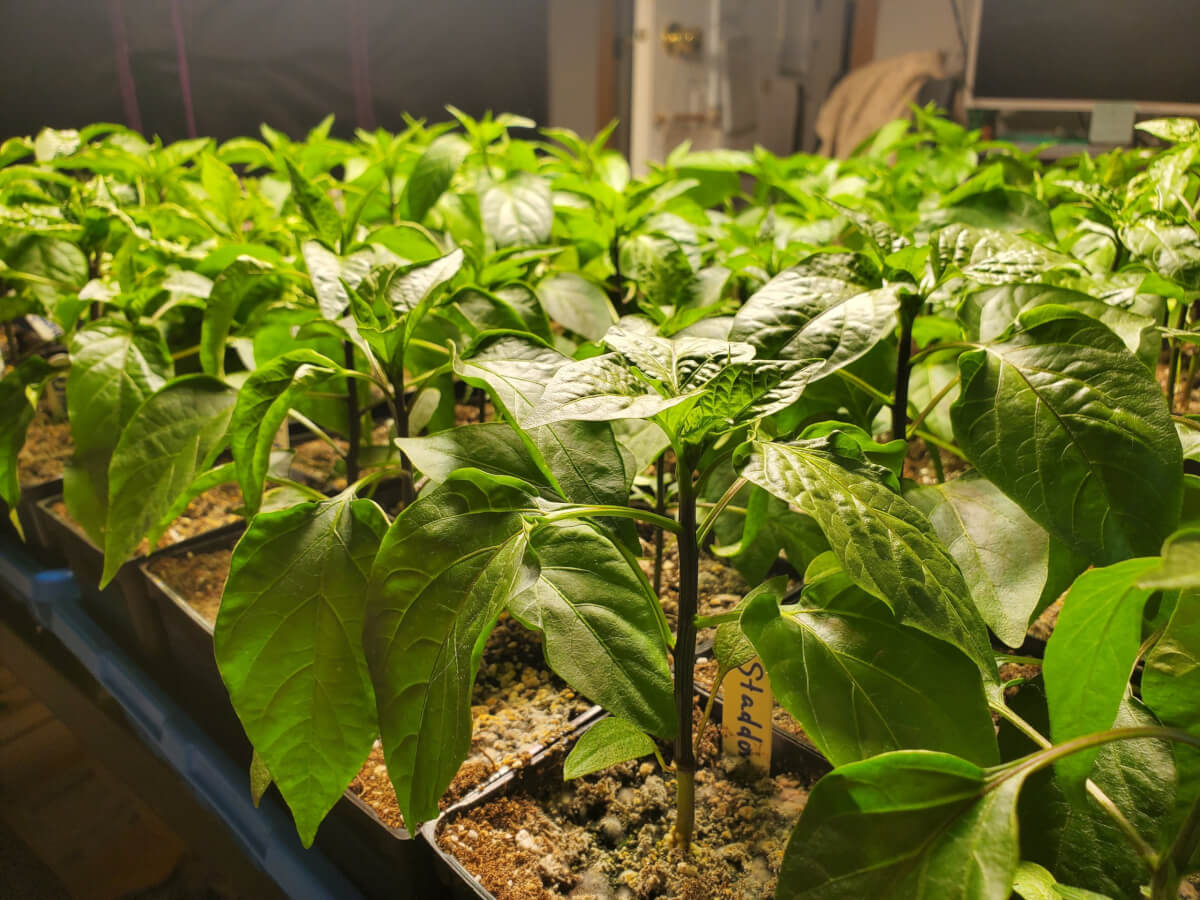
When our pepper plants get to about this size, we will often transplant them up to a larger pot. This allows them to grow even larger, which increases production.
If your indoor garden is cramped for space, 5.5 inch pots may not be the best idea in the early season. Peppers are not super sensitive to transplanting, so it’s fine to consider a smaller pot (we recommend 3.5 inch) as an interim transplant step.
Once most of your cold hardy plants are happily living outside, you can up-pot your peppers to these larger pots. This allows us to use our indoor growing space for further pepper plant maturity and ideal size growth.
Assist Your Pepper Pollination
Alaska and many northern climates tend to have less numbers of naturally pollinating bees and flies.
It’s very helpful to assist your peppers in the pollination process as it will lead to increased yields.
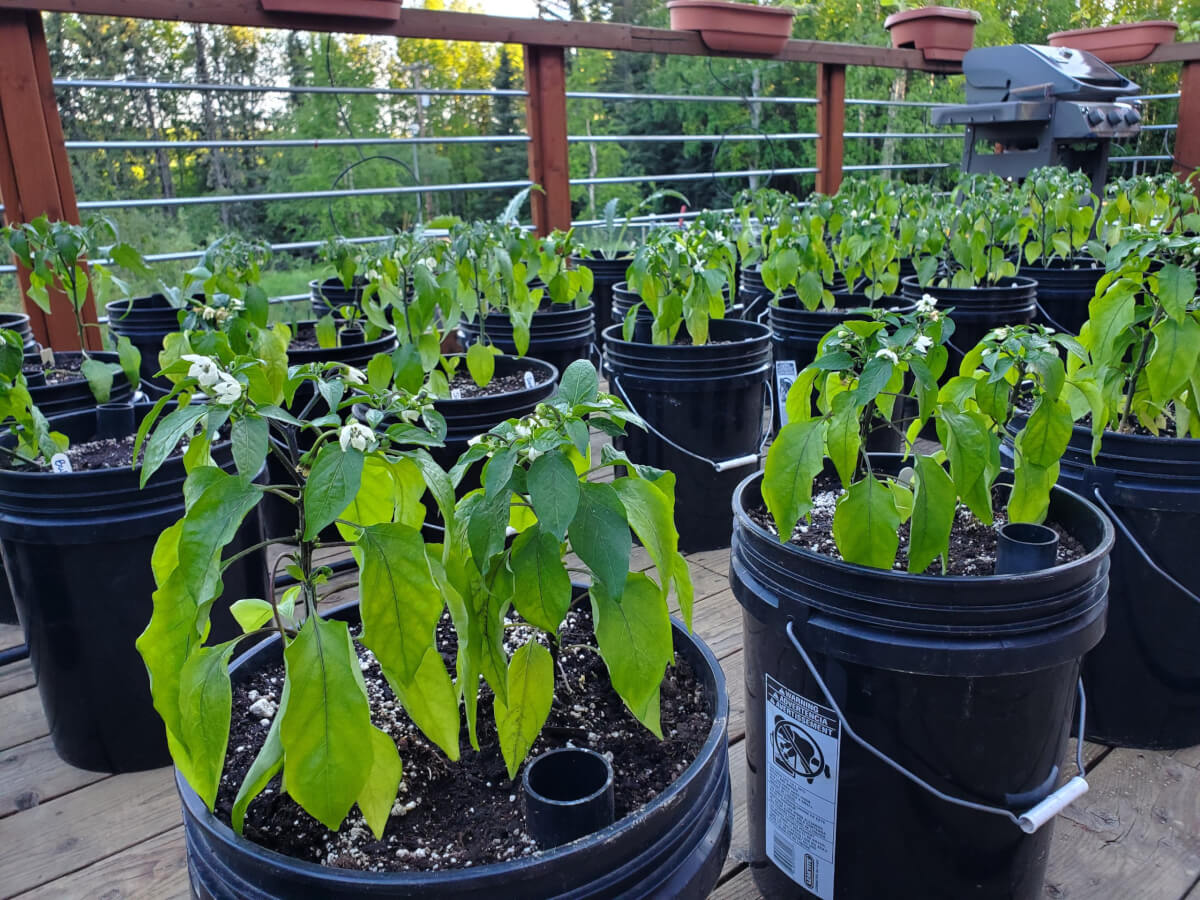
Just like with tomatoes, peppers are self-pollinating. This means that the flower can pollinate itself.
You can virtually guarantee pollination if you tickle/shake the flowers as they open.
We like to repeat this once every few days as long as the pepper is putting out flowers. Some people use electric toothbrushes or other gizmos, but we’ve found great success with gentle use of our fingers.
Aggressively Feed Your Peppers
As with all vegetables grown under the midnight sun, peppers will eat a lot more when exposed to 18+ hours a day of sunlight. Often, even a rich compost is not enough food for them to last the entire season.
It is a good idea to supplement your peppers with regular fertilizer throughout the summer.
Once your peppers have a couple sets of true leaves, it’s time to fertilize them. Early in the pepper’s life, you want to use a high nitrogen based fertilizer to encourage the plant’s growth. This will help the plant to grow larger, which in turn results in higher yields.
It’s always best to check your fertilizer’s instructions for seedlings. If it is not stated, a good starting point for seedlings is usually 1/4 the “normal” dose.

Once the plant starts to put out flowers or upon planting outdoors, transition the plant to a fertilizer higher in phosphorus and potassium. (i.e. higher P & K values or the last two sets of numbers on a fertilizer’s rating)
Tomato specific fertilizers are a good choice as peppers share similar nutritional needs.
Follow your fertilizer directions, but we are often fertilizing every 7-10 days to fuel more rapid growth. In our sub-irrigated containers, we tend to treat them like hydroponics and provide a constant feed rate of fertilized water.
Have A Plan For Pepper Maturity
When you look at seed packets for peppers, the maturity date is defined as an edible green pepper. That may not match your expectation of a ripe pepper. It can take quite a few days (or even weeks+) for a pepper to fully ripen.
Peppers ripen best in warmer temperatures. In interior Alaska, August can often be a rainy, cooler month. This can make it challenging to grow peppers as your prime time for ripening are less than ideal for it.
Some varieties, however, will ripen just fine in those cool temperatures. We’ve found this true with Shipka/Padron, Bulgarian Carrot Pepper and often mini-bell varieties.
You may want to consider using an indoor growing space to ripen your peppers. If you can do this, you can grow almost any variety of pepper and get a rather decent yield of ripe peppers.
This technique also allows you to grow super-hot peppers that often need much more time to fully ripen. This is our biggest reason for using higher end LED lighting in our indoor garden, it allows us to finish growth cycles indoors if we want to.
Outdoor grown peppers don’t tend to get humongous in Alaska like they do in warmer climates. We usually see about 2-4 feet tall, with most on the shorter side. This is often a manageable height for moving them indoors, if you choose to do so.
Your plants should be aphid-free if you decide to do this. Aphids populations will explode if brought indoors and can risk houseplants getting them. More on this in the next section!
Keep An Eye Out For Bugs
The lack of garden pests in Alaska is probably one of the best reasons we like to grow here. We aren’t fighting beetles, caterpillars and slugs.
But, some years we can get infestations of aphids. They are horrible. These dastardly bugs absolutely love pepper plants and will destroy them if allowed to.
 Periodically, you should be checking your pepper plants for aphids or other pests. If your plants are having a hard time all of a sudden, this is one of the first things you should check for.
Periodically, you should be checking your pepper plants for aphids or other pests. If your plants are having a hard time all of a sudden, this is one of the first things you should check for.
You will find aphids crawling on the backs of the leaves and plant stems. They are tiny, so you have to look carefully. If you see symptoms of plant health that can’t be attributed to watering or feeding issues, look for aphids.
If you get an infestation, it’s a good idea to resolve it as soon as possible and across your entire garden. They are likely also elsewhere, on other plants.
A popular method of aphid control is neem oil. Most brands of this are organic and it’s generally safe to apply. There are oil based versions and sprays and for our scale of gardening, a spray bottle is preferred.
We keep a bottle of pre-mixed neem oil ready all the time. This allows us to respond immediately if we locate aphids. The spray seems to remain effective, even when mixed with water.
If neem oil doesn’t cure your bug ills, you may need to escalate to an insecticide. These are more harsh and can be harmful to humans, so be careful in their application.
Be certain that an application of insecticide is food safe. To be clear, it’s still not safe, but it should wash off with ease. There are similar products that aren’t food safe, these are intended for non-edible plants. As with neem oil, apply the insecticide to the backs of leaves and stems of the plant.
Regardless of whether you use pesticides, it’s a good idea to thoroughly wash your vegetables before you eat them. This is recommended even if you use neem oil, which is generally regarded as safe.
Grow More, Smaller Plants
If peppers are your jam, you would do well to heed this advice.
The truth about peppers in extreme northern climates is they will end up being smaller than peppers grown at lower latitudes.
You won’t have hundreds of peppers falling off any pepper plant grown in Alaska.
You can still get an epic pepper harvest, but you may need to think in terms of plant quantity over plant quality.
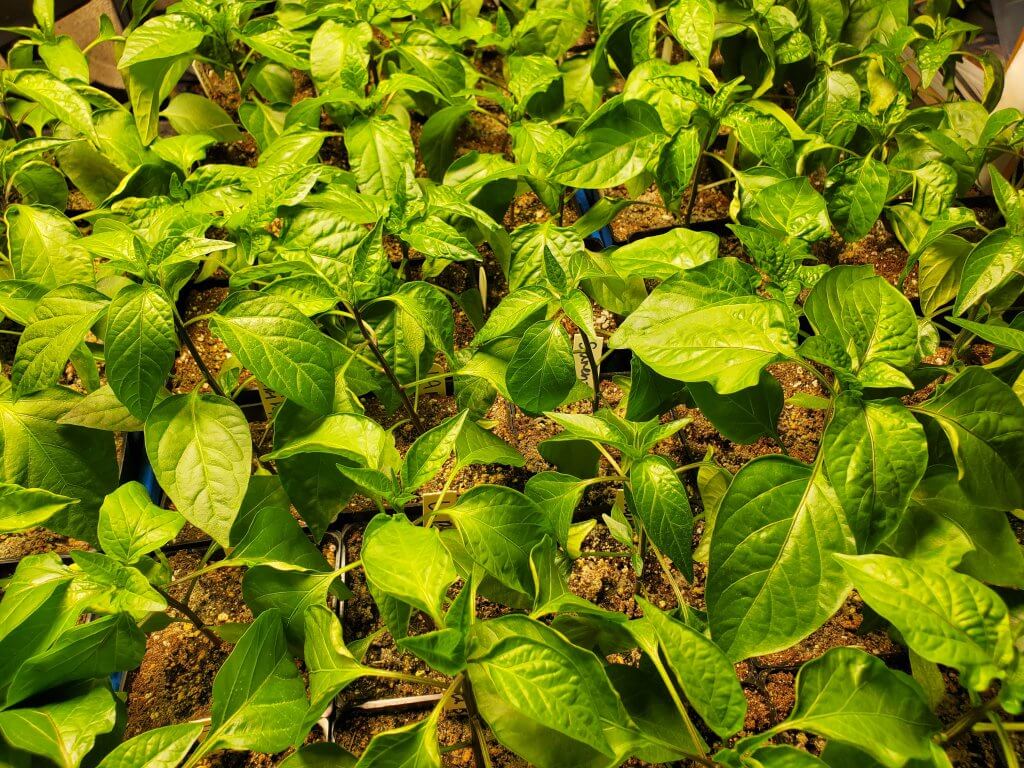
Since our northern plants don’t tend to get as large, you can also use tighter plant spacing with subarctic grown peppers. For example, these days, we’re growing two pepper plants in a single 5 gallon bucket.
One thing we’ve started doing with our pepper gardens is to focus on growing more of a single kind of variety pepper. We’ve really taken to jalapenos and there’s a great variety of them out there. Plus, they’re all perfectly edible when green.
This allows for greater production of a single type of pepper in the same amount of space.
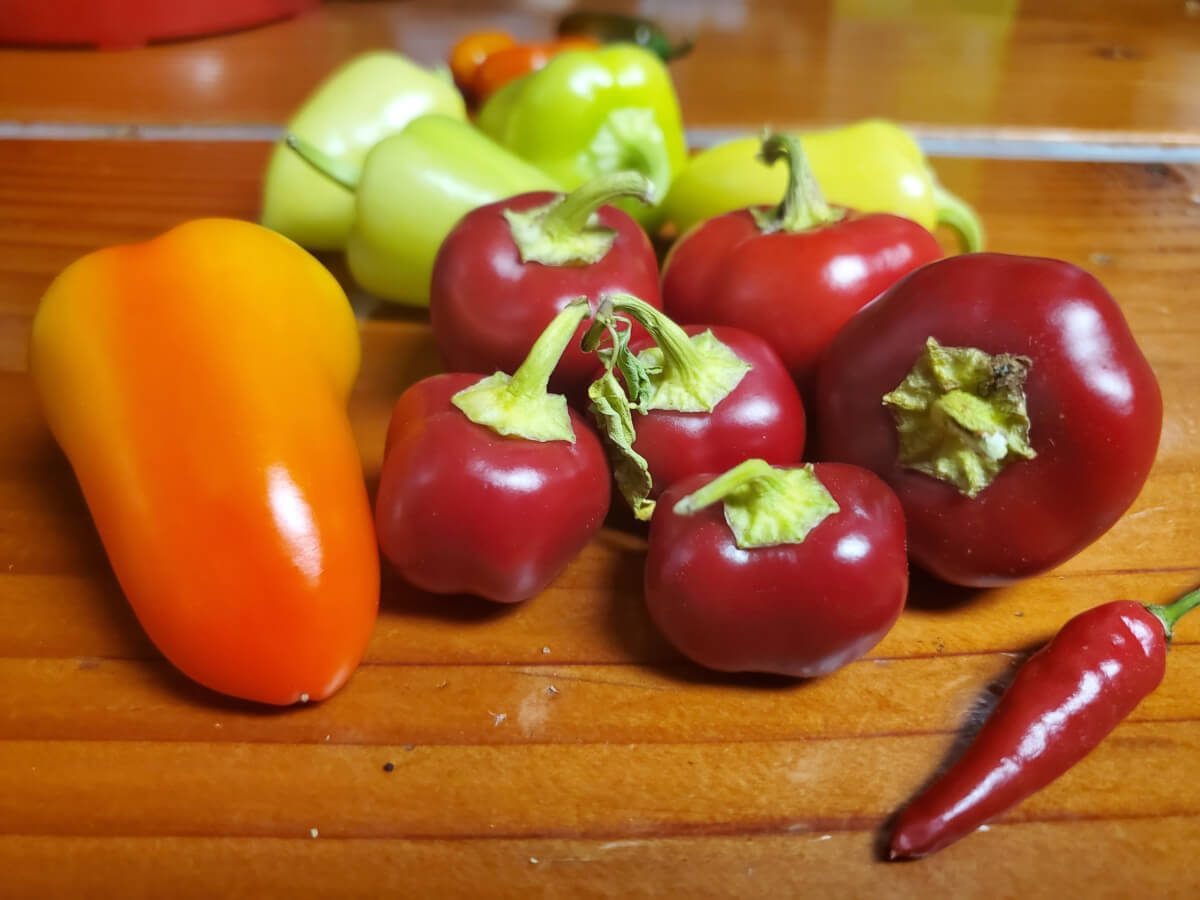
The Right Tool For The Subarctic Job
The focus of this post is primarily about outdoor grown peppers, particularly grown in subarctic climates. That said, there’s a lot of advantages to having a greenhouse.
Fundamentally, the greenhouse allows the northern gardener to artificially increase their temperatures. Peppers will absolutely respond really well to this and reward you with greater and more frequent harvests.
In many ways, having a greenhouse does open some opportunities to branch out a little further into growing different kinds of peppers in the extreme north. That said, it’s not a miracle, either.
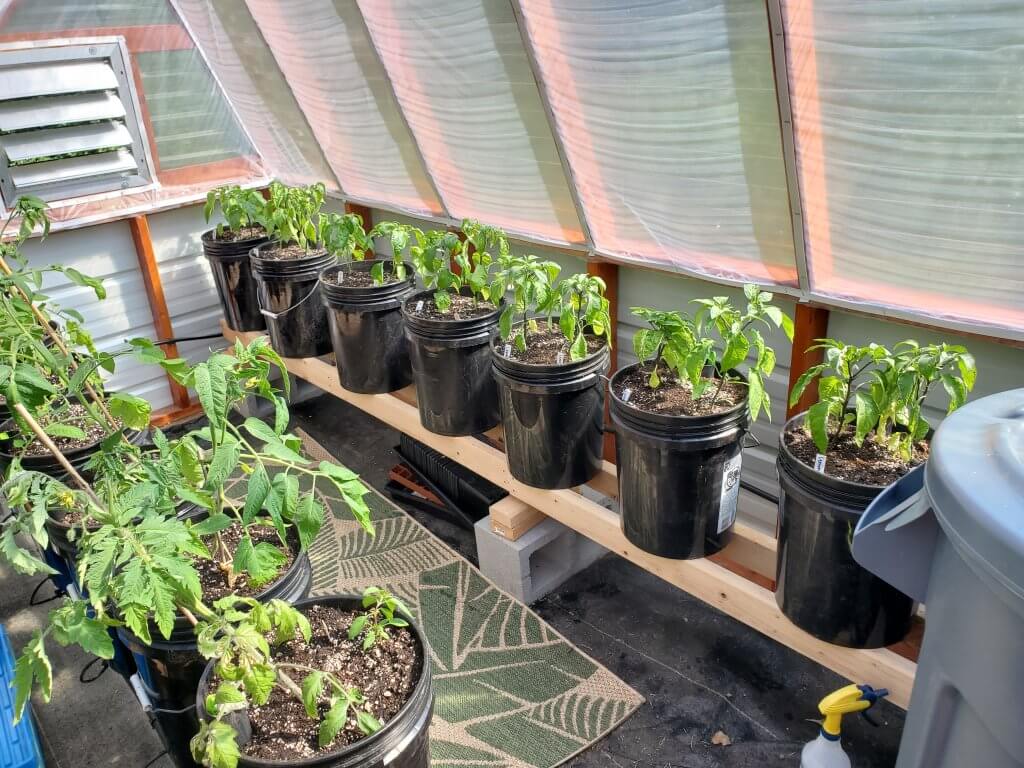
We use our greenhouse primarily to get full maturity of colorful jalapenos and some early season sweet peppers. Sometimes we use it to test new, experimental varieties.
Perhaps surprisingly, we try to grow the overwhelming bulk of our peppers outdoors. We focus on varieties that do well outdoors and use our greenhouse for a few specialty peppers. Our greenhouse is used to benefit peppers that will benefit the most from the added heat.
Even if you have a greenhouse, like we do, we still follow all the advice that we have offered above. The greenhouse doesn’t fix every problem with growing peppers in the subarctic, just a few of them.
In Conclusion
Peppers are a great addition for the preserver and add a great dimension to food. They are some of our favorite things to grow, despite the difficulty from a cold climate!
We use them not just for fresh eating, but also preserve the majority of our harvests.
Every year, we try to come up with interesting things to do with our pepper harvest. When stored properly, some of these things can last for years.
- Hot sauces
- Fermented hot sauces
- Pepper powders (and mixes)
- Pepper flakes (and mixes)
- Dried peppers
- Frozen peppers
- Ingredient in various other preserved foods
We hope that you enjoyed our tips for growing peppers in the subarctic and other cold climates. If you have any tips yourself, feel free to leave a comment.
That’s All We Wrote!

Having a good time? We have an ever growing list of insightful and helpful subarctic & cold climate gardening articles, waiting out there for you!
- Cold Climate Gardening Basics 👉
- Growing Your Garden From Seed Indoors 👉
- Advanced Cold Climate Gardening Techniques 👉
- Plant Specific Cold Climate Growing Guides 👉
- Subarctic Perennial Food Forests & Foraging 👉
- Indoor Garden Lighting & Grow Rooms 👉
- Greenhouses & Temperature Control 👉
- Harvesting & Food Preservation 👉
- Solving Cold Climate Garden Problems 👉
- 1 Minute Reads On Tons Of Garden Topics 👉
FrostyGarden.com is 100% ad-free and we do not use affiliate links! This resource is voluntarily supported by our readers. (Like YOU!) If we provided you value, would you consider supporting us?

Very nice article
Thank you! Glad you liked it.
Have you tried overwintering pepper plants year to year? It may make for some somewhat longer growing seasons when the plants don’t need to do their maturing in the same season they’re producing all the fruit you’ll ever get from them.
We have done this before and it does work well. Totally agree that second year+ peppers do much better. We stopped doing it as the risk of aphids was a bit too high and put our houseplants at risk. I think if we had a climate controlled garage and could keep them out of the house, we’d definitely consider it again.
I feel the information is really really needed and handy. I would like to have information on growing in the south, as I am new to this, never done this, and I’m having a hard time.
We can’t help much with southern growing specifics, mostly because we’ve always been northern growers. There’s lots of folks doing it out there! But, we do know a lot of general things! The biggest keys are getting watering right (moist, not dry or saturated) and keeping your plants well fed (we recommend regular applications of water soluble fertilizers). In the south, heat can be a major concern. Above 100F/37C, many pepper varieties will start to have troubles with the heat. It may be necessary to use shade cloth over your plants to slightly cool them. Many growers in places like the US southwest will shift their growing season from the summer to “spring” or “fall” (or even winter in some places) to avoid the peak heat of summer. There are few plants that tolerate temperatures above 110F/43C, even with regular watering.
If you share some more specifics about what you’re dealing with, we might be able to provide further insight. A lot of growing is about the basics, which is the same regardless of latitude!